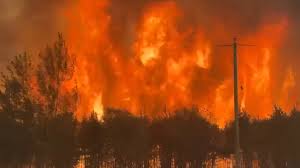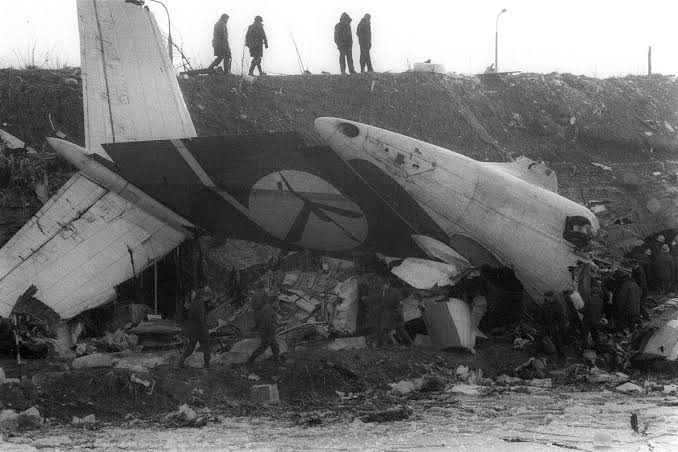“Over 2,500 Wildfire Evacuees Find Shelter in Niagara Falls as Manitoba Fires Rage On”
Over 2,500 Wildfire Evacuees Find Shelter in Niagara Falls as Manitoba Fires Rage On
Niagara Falls, Ontario — June 2025 — As wildfires continue to devastate large parts of northern Manitoba, over 2,500 evacuees, primarily from Indigenous communities, have found temporary refuge in Niagara Falls, Ontario. This sudden and urgent relocation effort highlights both the strength and strain of Canada’s emergency response systems as well as the unbreakable spirit of displaced families seeking safety.
🔥 The Wildfire Crisis in Northern Manitoba
In late May, fast-moving wildfires broke out across northern Manitoba due to a combination of extremely dry weather, high winds, and unseasonably warm temperatures. Within days, flames had engulfed vast swaths of land, threatening homes, critical infrastructure, and natural habitats.
The most heavily impacted areas include remote Indigenous communities like the Mathias Colomb Cree Nation, whose residents were forced to flee with little notice. The intensity of the fire and its unpredictable spread left local authorities with no choice but to order full-scale evacuations.
By the first week of June, more than 30,000 people had been evacuated from the affected regions, with emergency shelters and hotels across Manitoba and Ontario rapidly filling to capacity.
🛑 A Long Journey to Safety
Among the evacuees were families, elders, and young children flown or bused nearly 1,500 kilometers to Niagara Falls — a region better known for tourism than emergency housing.
Upon arrival, the displaced individuals were met by emergency personnel, social workers, Indigenous support networks, and volunteers, who worked tirelessly to provide food, shelter, medical care, and mental health services.
The evacuees have been housed in various hotels throughout Niagara Falls, including chains along Lundy’s Lane and Clifton Hill. For many, this marks their first time outside their communities in years, if ever.
“I’ve never left home before. It’s overwhelming,” said Marie Blacksmith, a 17-year-old from Pukatawagan. “But everyone here has been kind. We’re just grateful to be safe.”
🏨 Strain on Local Resources
The arrival of thousands of evacuees has put a noticeable strain on Niagara Falls’ already-busy hospitality sector, especially with the summer tourism season underway.
Many hotels are operating at or near full capacity. Some tourists have had to reschedule their trips or find accommodations in nearby cities like St. Catharines or Welland.
Local businesses and community leaders have called on both provincial and federal governments to assist in managing the crisis, citing the need for additional funding and resources.
“We’re doing everything we can to help,” said Mayor Jim Diodati of Niagara Falls. “But our city needs support. This is a national crisis and it requires a coordinated, well-funded response.”
🧡 Community Support and Volunteerism
Despite the challenges, the Niagara Falls community has rallied in support of the evacuees. Faith groups, cultural organizations, and private citizens have organized donation drives, hosted welcome dinners, and delivered essentials like diapers, blankets, and toiletries.
The Niagara Regional Native Centre has played a central role, providing culturally relevant care and acting as a liaison between local services and Indigenous evacuees.
“We’re working around the clock,” said Tanya Whitecloud, a coordinator at the Centre. “These families have experienced trauma — losing homes, being uprooted — and they need more than just shelter. They need compassion, respect, and long-term planning.”
💬 Evacuee Voices: Stories of Resilience
Many evacuees, while shaken, have expressed gratitude for the hospitality shown to them and remain hopeful for their future.
David Moose, a 48-year-old teacher from Mathias Colomb Cree Nation, shared, “We left everything behind — homes, schools, memories. But what matters most is that we’re alive. We’ll rebuild, no matter how long it takes.”
Children have been enrolled in local schools, elders have been connected with health clinics, and families are slowly adapting to their temporary surroundings.
Still, uncertainty looms. No one knows how long they will need to stay in Niagara Falls, or what awaits them back home once the fires are extinguished.
🔍 Government Response and Criticism
The federal and Manitoba provincial governments have promised financial aid and logistical support. Prime Minister Justin Trudeau addressed the situation in a recent press conference, stating:
> “Our thoughts are with all those displaced by the wildfires. We are committed to ensuring every family has the support they need to recover and return home when it is safe.”
However, critics argue that the government’s response has been too slow and reactive, particularly regarding housing and long-term support for Indigenous communities disproportionately affected by climate disasters.
“The same story repeats every year — fire, floods, evacuation. But where is the long-term plan?” asked NDP MP Leah Gazan. “These communities deserve more than crisis management. They deserve climate justice, infrastructure, and investment.”
🌍 Climate Change and Future Risks
Experts warn that the severity and frequency of wildfires in Canada are increasing due to climate change. Drought conditions and rising temperatures have created a volatile environment in many forested regions.
Dr. Kyle Murdock, a wildfire specialist at the University of Manitoba, explained:
> “What we’re seeing in 2025 is the new normal. More fires, more evacuations. Communities, especially in the north, are on the front lines and urgently need mitigation strategies — from better firefighting infrastructure to community-led emergency planning.”
📆 What’s Next?
As of mid-June, the wildfires in northern Manitoba are still burning, although fire crews have made some progress in containing key zones. The timeline for when evacuees can return home remains unclear.
Meanwhile, Niagara Falls officials are working with provincial and Indigenous leaders to improve living conditions for those displaced. Discussions are also underway about longer-term housing options in case the fires last deep into summer.
For now, the city remains a place of safety — a temporary home for thousands fleeing disaster.
—
📝 Final Thoughts
The wildfire crisis in Manitoba and the relocation of thousands to Niagara Falls is a powerful reminder of the growing challenges posed by climate change, especially for vulnerable and remote communities. It also reveals the deep compassion of ordinary Canadians — from hotel staff to local volunteers — who have stepped up in a time of great need.
As the fires continue to burn and families remain in limbo, the eyes of the nation turn to how leaders will respond — not only in the days ahead, but in preparing for a future where such emergencies are all too common.
—






